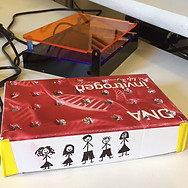Choose a DNA sequence that interests you from nature or a source like the iGEM part registry. Provide a detailed workflow for isolating or acquiring a molecule with this specific sequence and an assay that confirms part of its content.
To make a protein in a cell, you need a promoter, ribosome binding site (RBS), protein coding sequences (CDS) and a terminator. A promoter is a DNA sequence that tends to recruit transcriptional machinery and lead to transcription of the downstream DNA sequence. The RBS is an RNA sequence found in mRNA to which ribosomes can bind and initiate translation. CDS are DNA sequences that are transcribed into mRNA and in which the corresponding mRNA molecules are translated into a polypeptide chain. They consist of codons, three nucleotides each, usually begin with the start codon ATG and end with a stop codon. Terminators are genetic parts that usually occur at the end of a gene or operon and cause transcription to stop (iGEM).
For this assignment, I decided to work with pUC19 because we use this plasmid in the lab task. pUC19 is a commonly used cloning vector in E.coli that conveys Tet (tetracycline) and Amp (Ampicillin) antibiotic resistance. The "p" in the name pUC refers to plasmid and "UC" is an abbreviation for the University of California, where this vector was developed. It has 2686 base pairs and a high copy number.
Digesting a DNA substrate with two restriction enzymes simultaneously (double digestion) is a common time-saving procedure. We used the restriction enzyme PvuII-HF and the CutSmart® Buffer from New England Biolabs. The HF in the restriction enzyme refers to High-Fidelity, which means the digestion is faster (in only 5-15 minutes), of better quality and the enzymes have a 100% activity in the CutSmart Buffer. The results of the gel electrophoresis will be without "star activity", unwanted cleavage outside their defined recognition sequence sites.
For acquiring a specific sequence, two questions arise:
-
Where will the restriction enzyme cut in the plasmid?
-
How many cut sizes are there?
To answer these questions, I imported pUC19 in the software Benchling. The restriction enzymes PvuI and PvuII cut the plasmid in two places, which means the plasmid splits up in two different DNA fragments. For PvuII, this happens at the following sites in the DNA sequence:
5'...CAG | CTG...3'
3'...GTC | GAC...5'
The expected results of the digest are given in the tables below and the positions of the fragments are visualized on the right.

CLASS ASSIGNMENT
THEORETICAL HOMEWORK

lab task
EXPERIMENTAL HOMEWORK

Description
Tools to make specific cuts in DNA initiated discussion of “synthetic biology” as far back as the 1970s. The first of these genetic scissors were purified restriction enzymes, which are bacterial proteins that bind and break DNA at sequences they recognize to provide immunity to viruses. PvuII is an example of a restriction enzyme that recognizes CAGCTG and cuts (or “digests”) right down the middle (though restriction enzymes can also cut each strand in a way that leaves short overhangs, as seen for HindIII in the figure below). Our circular DNA plasmid pUC19 has >1 CAGCTG sites, which leaves multiple PvuII-cut fragments that can be separated into size-dependent bands by gel electrophoresis. This week we will cut DNA and compare the sizes of cut fragments to predicted outcomes from the sequence map of our plasmid.
Lab Task: Verify restriction digest of a circular DNA plasmid by gel electrophoresis. Compare your experimental result with what you would predict from the plasmid map.
Protocol
1. In two separate tubes sized appropriately for your 37C source, mix the following:
-
pUC19 ( 1ug / ul) 2 ul
-
PvuII-HF (20 Units / ul) 1 ul
-
Cutsmart Buffer (10x) 3 ul
-
Deionized Water 24 ul
2. Incubate one reaction mix at 37C for 1 hr and move the other into a refrigerator (~4C)
3. Cast a 1% agarose TAE gel
-
Add 1 g agarose to 100 mL 1x TAE (10 mL 10x TAE and 90 mL water) and swirl
-
Microwave until agarose is fully dissolved (2-3 min) and before solution boils over
-
Mix in 10000x DNA gel stain (10 uL for every 100 mL gel)
-
Cast the gel in a tray with a well-forming comb inserted and wait ~1 hr to set (solidify)
4. Load gel with completed digests
-
Orient solid gel so wells line up on the negative electrode side of the electrophoresis cell ("box")
-
Fill gel box with 1x TAE until the gel is submerged and remove comb
-
Mix samples with 6x DNA loading dye (6 ul dye for every 30 ul sample)
-
Pipette DNA ladder into the first well, an uncut plasmid negative control into the second well, the 37C-incubated PvuII-cut sample into the third well, and the 4C-refrigerated sample into the fourth well.
5. Run for ~1 hr at 120V or until the dye front has traveled ¼ of the gel’s length
6. Image DNA separation through an orange filter over a blue-LED transilluminator.







Results
The digest of the ladder in the first slot worked, because the fragments are visible. The second well contained the pUC19 without restriction enzymes. The large plasmid traveled quite far and accumulated in one spot. The experiment seems to be successful, because the digests in slot 3 and 4 are clearly visible in the expected location at around 2.5 kb. The second fragment is barely visible, even the ladder starts to look faint further down the digest.

BIO
DESIGN
"DNA modification is fundamental to design in synthetic biology. For this week's assignment, you will learn to read DNA sequence files and see physical changes you will make to DNA molecules."


PvuI digest
PvuII digest
Digest with DNA fragments cut by PvuI and PvuII
Hover to find PvuII


Synthetic Biology Open Language (SBOL) standard visual symbols for use with BioBricks Standard
PUC19 plasmid map made with Benchling
1 2 3 4